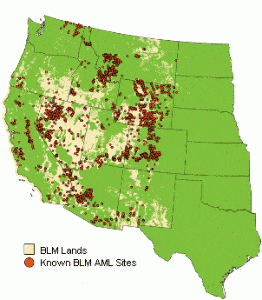Robert Hughes stopped his maroon SUV in the middle of Espy Street, turning on his flashers to let drivers know he might be there for a while.
He knelt by an uncovered hole in the street, about the diameter of a coffee can, and spooled a yellow, metal-tipped measuring tape into the dark. He lowered the tip 23 feet before a beep let him know it had touched water.
He had found the surface of the pool that formed in the abandoned coal mine beneath the Wilkes-Barre neighborhood.
“Do you think all these people here know there’s water 23 feet below their houses?” Hughes said, nodding toward the homes about a hundred feet away. “Doubt it.”
Borehole measurements are some of the data Hughes, 41, is using to create three-dimensional maps of the abandoned mines below the Lackawanna and Wyoming valleys. As executive director of the Eastern Pennsylvania Coalition for Abandoned Mine Reclamation, part of his job is studying the underground lakes and orange creeks left over from the anthracite coal era.
Last week, the state Department of Environmental Protection’s Mine Subsidence Insurance Board issued the coalition a three-year grant of $321,968 to map the honeycombed voids beneath the anthracite region.
“If I was going to build a house anywhere in this area, I wouldn’t only be concerned about whether or not there has been mining in there, I’d be concerned if there was water beneath your house,” Hughes said. “You can get flooded basements; you can get subsidence in those areas where there is a mine pool beneath you. It’s just a matter of how deep that mine pool is and how much cover is on the roof of the rock beneath your house.”
Subsidence is one of the lingering reminders of the long, often bloody, history of coal mining in Northeast Pennsylvania. According to a history of anthracite coal mining compiled by the federal Mine Safety and Health Administration, anthracite mining in the area began in 1775, peaked in the 1910s and steadily declined after.
By 1987, the total weight of anthracite pulled from the ground was less than 10 percent of what it was in 1917.
For residents with long ties to the area, subsidences barely raise an eyebrow. As the earth’s surface settles into the voids below, hundreds of these events occur every year.
Bernard Walko, planning unit engineering manager at the Bureau of Abandoned Mine Reclamation, said between Jan. 1 and June 30, 2013, the department received 105 inquiries regarding abandoned mine lands. He said it received a total of 185 inquiries in 2012, 359 in 2011 and 218 in 2010.
Walko said the number of possible subsidences reported to the DEP fluctuates every year. In years with heavier precipitation, he said, underground water pressure can lead to more subsidences.
The risk of such an event happening to one person is low, said Lawrence Ruane, administrator for the Mine Subsidence Insurance Board. Only one in 2,000 people who take out subsidence insurance policies ever sustains a loss, he said. This explains why only 5 percent of people at risk of subsidence purchase insurance.
“They just think that they’re not going to be that unlucky person,” Ruane said.
Plumbing the Depths

Digitizing the thousands of maps will help the board and the public see what lies beneath their homes or businesses, he said. More complete maps will be especially useful in the anthracite region, which has not been mapped thoroughly.
Ruane envisions the final product being available online, so a resident could type in an address and see a picture of his or her location with an image of the mines underneath.
“A picture is worth a thousand words,” he said. He also thinks the digital maps will cut down on the research time needed for claims.
“If we have that information in electronic form, what would take maybe days to research, they may be able to research in minutes,” Ruane said.
The Eastern Pennsylvania Coalition for Abandoned Mine Reclamation has already worked for years to define the boundaries of the mine pool. It was one of seven entities that received DEP grants to do the additional mapping. The other six grants went to colleges or universities.
DEP spokeswoman Amanda Witman said grant recipients will scan roughly 27,000 out of the 55,000 mine maps the department knows about. A few thousand will be used to create the new maps.
“This program basically allows us to share the burden of being able to examine, preserve, digitize, georeference and upload those maps,” Witman said.
After the maps are finished, DEP will use them on its new Pennsylvania Mine Map Atlas, Minemaps.psu.edu, which Witman said went online in May. DEP launched the website on May 30 after scanning and uploading 15,000 maps, a process that took 10 years.
The funding used to create the atlas and issue the grants came from coal mining license and permit fees, fines and penalties gathered under the Pennsylvania Surface Mining and Reclamation Act, Witman said.
‘Between their work and the work we have already done, there is still an opportunity out there to do even more for the Mine Map Atlas to make it as comprehensive as possible,” Witman said in an email.
‘Georeferencing’
At his office in Ashley next to an abandoned coal breaker, Hughes explained how he and his colleague, Michael Hewitt, turn 2-D paper maps into 3-D digital maps. The process is known as “georeferencing,” and, for them, it involves a lot of mouse-cursor tracing over the lines on scanned images of old mining company and government maps.
On his computer, Hughes pulled up a preliminary map he and Hewitt made by combining mining company maps with data from a series of reports from the U.S. Bureau of Mines in the early 1950s. The map shows the horizontal extent of the pool that formed when the abandoned mines flooded, along with arrows that show the direction of the water’s flow.
EPCAMR also measured the water depth in several of the approximately 40 bore holes all over the Wyoming and Lackawanna valleys. The measurements help Hughes and Hewitt draw boundaries for the underground lakes.
“We would measure the water elevation inside of that bore hole to get at what the elevation of the pool is,” Hughes said. “That elevation of the water, we extend it out underneath the ground to the contour of the underground mine workings.”
The map they created using these methods is still two-dimensional. To add the vertical axis, Hughes is using cross-section maps of the Lackawanna and Wyoming valleys, which he lines up on a virtual plane. The series of cross-sections looks like a set of sheets hung up on a virtual clothesline. Hughes said this process is known as “curtaining.”
He uses a mouse to trace the lines on the cross-sections representing rock, coal and void space. Combining this with the horizontal map yields a digital, 3-D representation of the Lackawanna and Wyoming valleys.
When completed, the maps could help property owners decide whether to carry the department’s mine subsidence insurance, Witman said. She said the average cost to repair a home with mine subsidence damage is $50,000.
Ninety-five percent of people living in mine-affected areas do not carry subsidence insurance, Ruane said. But most residents do know about it, according to the board’s surveys.
“The vast majority of people in the mining region know about mine subsidence and know about mine subsidence insurance,” he said. Most are simply willing to take a risk.
Keith Tucker, executive director of Lackawanna Neighbors Inc., said his organization carries mine subsidence insurance on the properties it manages.
He said one subsidence in the 1990s did $200,000 of property damage to a 10-acre site. In summer 2012, a sewer line disappeared underneath Midtown Apartments on Adams Avenue. Tucker said when a construction crew cut into the kitchen floor in the apartment complex, they found a void underneath.
The most recent incident was a few months ago at Vine Street and Adams Avenue. Tucker said the corner of a building was cracking, so he called DEP. Within a day, the department arrived to prop it up, he said.
“If I had a home, I’d like to see it and look at what’s under my house,” he said.
Was this article valuable?
Here are more articles you may enjoy.

 Mattel Settles Baby Sleeper Death Suits Before Start of a Trial
Mattel Settles Baby Sleeper Death Suits Before Start of a Trial  Citi Reverses Course on Firing of Japan Trader Five Years On
Citi Reverses Course on Firing of Japan Trader Five Years On  Four Ex-VW Managers Convicted in Germany Over Diesel Scandal
Four Ex-VW Managers Convicted in Germany Over Diesel Scandal  Hackers Abuse Modified Salesforce App for Data Theft and Extortion, Google Says
Hackers Abuse Modified Salesforce App for Data Theft and Extortion, Google Says 